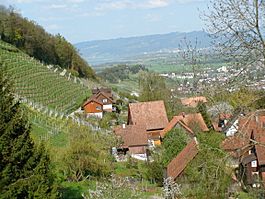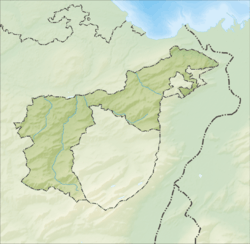Lutzenberg, Switzerland facts for kids
Quick facts for kids
Lutzenberg
|
||
|---|---|---|
 |
||
|
||
| Country | Switzerland | |
| Canton | Appenzell Ausserrhoden | |
| District | n.a. | |
| Area | ||
| • Total | 2.25 km2 (0.87 sq mi) | |
| Elevation | 538 m (1,765 ft) | |
| Population
(Dec 2020 )
|
||
| • Total | 1,271 | |
| • Density | 564.9/km2 (1,463/sq mi) | |
| Postal code |
9426
|
|
| Surrounded by | Eggersriet (SG), Heiden, Rheineck (SG), Rorschacherberg (SG), Sankt Margrethen (SG), Thal (SG), Walzenhausen, Wolfhalden | |
Lutzenberg is a small town, also called a municipality. It is located in the canton of Appenzell Ausserrhoden in Switzerland. One of its small villages, called Tobel, is very special. It is recognized as an important heritage site for the whole country.
Contents
A Look Back: Lutzenberg's History
Lutzenberg was first mentioned in official papers in 1634. Back then, it was part of a bigger area. This area was called the Kurzenberg.
The Kurzenberg included Lutzenberg, Heiden, and Wolfhalden. In 1658, these three places decided to become separate towns. This happened even though the canton government did not want it. Their official borders were finally set between 1666 and 1667.
Lutzenberg's Geography
Lutzenberg is a small municipality. Its total area is about 2.3 square kilometers (0.9 square miles). This was measured in 2006.
Most of the land, about 55.5%, is used for farming. Forests cover about 25.1% of the area. The remaining 19.4% of the land has buildings and roads.
Unique Features of the Town
Lutzenberg is the smallest municipality in its canton. It is also the only town there that does not have its own church.
The town is made up of two parts that are not connected. These two parts are called Haufen-Brenden and Wienacht-Tobel. Wienacht-Tobel even has its own train station. You can also find many scattered farmhouses around the area.
People of Lutzenberg
Lutzenberg had a population of 1,229 people in 2008. About 13.2% of these people were from other countries. Over the past 10 years, the number of people living here has grown slowly. It has increased by about 1.3%.
Languages Spoken
Most people in Lutzenberg speak German. About 91.7% of the population spoke German in 2000. English was the second most common language, spoken by 1.9% of people. Albanian was the third, spoken by 1.4%.
Age Groups in Lutzenberg
In 2000, there were slightly more males than females. About 52.7% of the population was male, and 47.3% was female.
Here is a look at the age groups in Lutzenberg in 2000:
- 7.3% of people were young children (0–6 years old).
- 13.5% were school-aged children (6–15 years old).
- 5.9% were teenagers (16–19 years old).
- 6.6% were young adults (20–24 years old).
- 32.7% were adults (25–44 years old).
- 20.6% were older adults (45–64 years old).
- 9.7% were seniors (65–79 years old).
- 3.8% were very old seniors (over 80 years old).
Education and Work
People in Switzerland generally have a good education. In Lutzenberg, about 71.5% of adults (aged 25–64) have finished higher education. This means they went to a special school or university after high school.
The unemployment rate in Lutzenberg is low, at 1.82%. This means most people who want to work have jobs.
Many people work in different types of jobs:
- Some work in farming (primary sector).
- Others work in factories or construction (secondary sector).
- Many work in services like shops or offices (tertiary sector).
Population Over Time
The number of people living in Lutzenberg has changed a lot over the years. Here is how the population has grown and shrunk:
| Historical population | ||
|---|---|---|
| Year | Pop. | ±% |
| 1667 | 518 | — |
| 1734 | 847 | +63.5% |
| 1813 | 700 | −17.4% |
| 1850 | 908 | +29.7% |
| 1900 | 1,353 | +49.0% |
| 1941 | 1,084 | −19.9% |
| 1950 | 1,233 | +13.7% |
| 1980 | 880 | −28.6% |
| 2000 | 1,323 | +50.3% |
| 2005 | 1,222 | −7.6% |
| 2007 | 1,220 | −0.2% |
See also
 In Spanish: Lutzenberg para niños
In Spanish: Lutzenberg para niños





